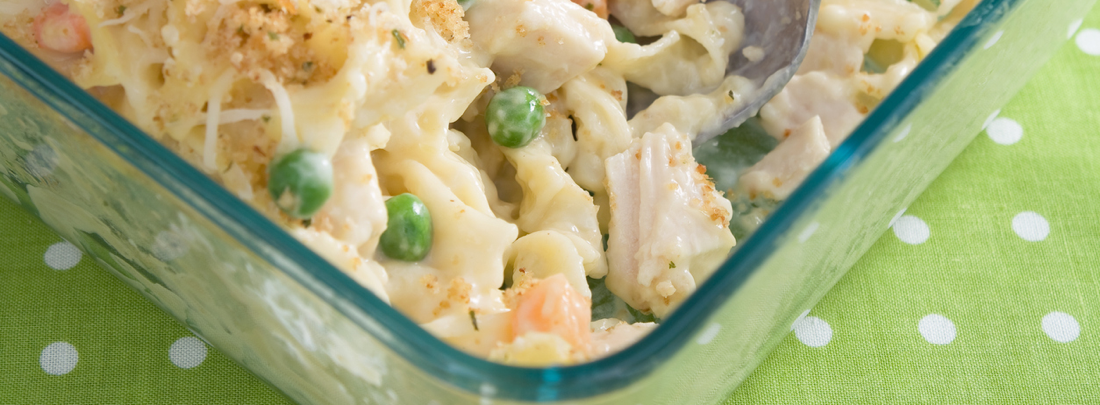Yep, it’s still winter–cold and rainy or perhaps piled high with snow where you live. No matter where you live, cold weather just makes you want to curl up beside a fireplace in a cozy, warm cottage doesn’t it? Comfort food is certainly on my mind at this time of year and one of the most comforting foods I can think of is a casserole. I remember my mom making casseroles several times a week in the winter. The heavenly smell as they baked in the oven drifted all through our small house and quickly lured me into to the kitchen.
Casseroles have a timeless appeal. Kids and adults like them, they can satisfy both vegetarians and meat eaters alike, and they can be frozen and reheated later. They are also a great opportunity to binge on healthy cool-weather vegetables like acorn squash, celery, potatoes, broccoli and carrots.
We also turn to casseroles when we’re not feeling our best. If you’ve struggled with the flu this Winter, you are certainly not alone. Both influenza and colds have been rampaging through the USA, leaving many patients ill for weeks to come. And what’s the first thing that we often turn to after a period of illness, why a comforting casserole that contains just enough protein and veggies but won’t push any stomach or gut buttons.
Here is one of my favorite casseroles. In addition to being tasty and comforting, the recipe is flexible enough that you can swap out ingredients if you don’t have something on hand. For instance, you can use cooked turkey, leftover store-bought broiled chicken, canned cooked chicken, or even canned water-packed albacore for the protein. For the bread cubes, you can substitute crumbled cornbread or even cooked pasta noodles.
Bev’s Chicken Casserole (Serves 4)
- 2 tablespoons butter or margarine
- 5 tablespoons all-purpose flour
- 1-1/4 cups chicken broth (low-sodium, MSG-free), divided
- 1 cup milk
- 1/2 teaspoon salt (omit if using broth that’s not low-sodium)
- 1/8 teaspoon garlic powder
- 1 dash white pepper (optional)
- 1/3 medium red onion, chopped & pre-fried as above (or 1 tsp. onion powder)
- 1-1/2 cups half-inch size, soft bread cubes (or cornbread crumbs or cooked pasta noodles)
- 1/2 cup finely chopped celery
- 2 tablespoons frozen peas or frozen carrots (optional)
- 3 cups cooked chicken, chopped
- 1 tablespoon chopped fresh chives
- 1 tablespoon Panko bread crumbs (optional)
- Non-stick cooking spray
In a medium saucepan melt the butter. Remove from the heat and stir in the flour until it is all absorbed. Return the pan to low heat and gradually stir in 1 cup of the chicken broth and all the milk until the sauce is thickened (don’t boil). Stir in the salt, garlic powder, pepper and onion (or onion powder). Remove from the heat.
Preheat oven to 350 degrees F. Combine bread cubes, cornbread crumbs, or noodles with the chopped celery in a bowl. Pour the remaining 1/4-cup of chicken broth over the mixture and gently toss. Spray a 10-inch square or 12×8-inch casserole dish with non-stick cooking spray. Place half the chicken pieces in the bottom of the dish. Cover with half the celery mixture. Sprinkle on the frozen peas or carrots. Top with the remaining chicken, then the remaining celery mixture. Pour the sauce over all and sprinkle the top with chopped chives and Panko crumbs (if desired).
Cover with foil or a heat-proof lid and bake at 350 degrees F. until hot and bubbly, about 30 to 35 minutes.
(A Note About Onions)
Many casserole recipes contain onions, a very flavorful vegetable with a reputation for triggering bladder and stomach distress. The reputation is well deserved too. While onions lend flavor to a dish, they also contain acidic sulfur compounds and naturally occurring sulfites. (Those sulfur compounds become airborne and are what make your eyes water when you slice onions.) Luckily for us though, there are some tricks to minimizing, or even eliminating, the impact of these bladder-irritating substances in casseroles with onions.
Before giving up completely on onions, try this:
- First, rinse the chopped or sliced onions before you use them in cooking. Cold water washes away some of the irritating chemical compounds that are released when the knife breaks the onion’s cells.
- The next step is to break down the sulfur compounds still inside the onion pieces by applying a high enough heat. It doesn’t mean you have to char the onions—just get them hotter than they’d typically get in a soup, stew, or casserole. The temperature achieved by boiling or microwaving is only a little more than 200 degrees F. That’s hot enough to kill bacteria and cook food but it isn’t hot enough to break down the onion’s sulfuric substances. The heat of frying however, is hot enough to do the trick. Cook the rinsed onions in a bit of oil (over medium heat) until they are translucent and barely starting to turn golden. Then put them in your casserole. (Just remember to dry off the onions with a paper towel before adding them to hot oil!)
- Lastly, if even the pre-fried onions in casseroles bother you, you can try substituting one tablespoon of onion powder for each medium raw onion called for in a recipe.

